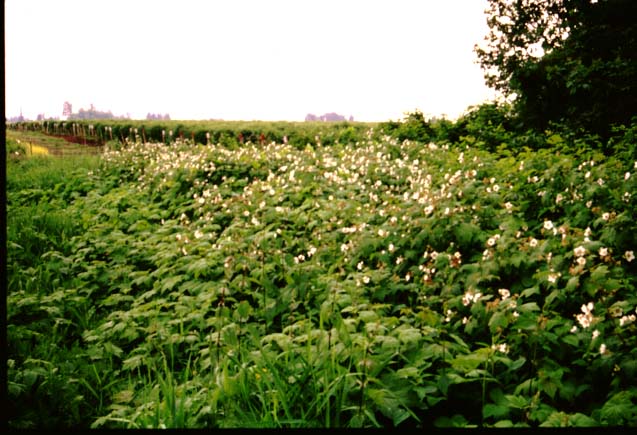Figure 7
Disease Cycle and Epidemiology
Inoculum SourcesRBDV is a seed- and pollen-borne virus that only spreads during bloom. The virus can be transmitted both horizontally and vertically. This means that when a raspberry flower is pollinated with RBDV infected pollen, both the embryo and the mother plant can become infected. The exact mechanism by which RBDV infects the seed and mother plant is unknown. There are many possible factors that could affect transmission including temperature and humidity levels, insect vectors and spread from native vegetation. Studies have already shown that native Rubus species such as thimbleberry (R. parviflorus) can be naturally infected with RBDV. This species is commonly found growing around raspberry fields in the Pacific Northwest (Figure 7) and could provide a source of RBDV inoculum. Mechanical transmission from plant to plant in the field is very unlikely as it is very difficult to inoculate raspberry seedlings by this means in the greenhouse, also spread is radially from a point rather than down a row.
Figure 8
Pollen Transmission
Pollen transmission can result in virus transmission through the seed (vertical transmission, one generation to the next) for which there are examples in many families of plant viruses. This could occur if the virus is present in the pollen tube and makes its way into the ovary. However, transmission to the maternal tissue and infection of the mother plant (horizontal transmission, transmission within a generation or through a field) is relatively rare with plant viruses. One proposed mechanism for horizontal transmission is that thrips feed on pollen which has a very high titer of virus then feed on maternal tissues and transmit the virus (Sdoodee and Teakle, 1987). Pollen on the petals of a flower (Figure 8) or on a leaf could serve as a source of virus for thrips transmission. This type of transmission has been shown for tobacco streak ilarvirus. Another possibility is that as the pollen tube grows down the style virus is transmitted to the maternal tissue of the flower and then spreads systemically through the plant.

